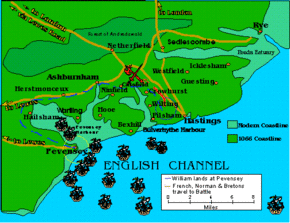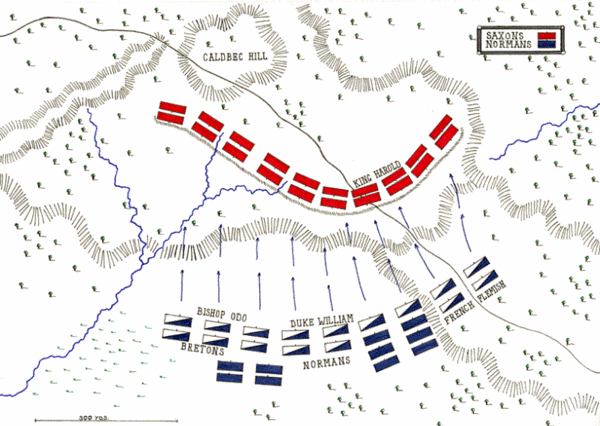Battle Of Hastings
 From Conservapedia
From Conservapedia | Battle of Hastings | ||
|---|---|---|

| ||
| Overview | ||
| Part of | Norman invasion of England | |
| Date | October 14, 1066 | |
| Location | Battle, near Hastings, England | |
| Combatants | ||
| England | Duchy of Normandy | |
| Commanders | ||
| Harold Godwinson | William the Conqueror | |
| Strength | ||
| 5,000 - 13,000 | 7,000 - 12,000 | |
| Casualties | ||
| possibly 4,000 | possibly 2,000 | |
The Battle of Hastings was fought on October 14, 1066, between William the Conqueror, Duke of Normandy and Harold Godwinson, Earl of Wessex. The issue of succession to the English throne provided the basis for the battle, with King Edward the Confessor dying without heirs. Both William and Harold claimed the English throne, the eventual result being the invasion of England by William to assert his claim. This battle is considered pivotal in the reconstruction of British rule, and is believed by some scholars to have led to the eventual conquest of Ireland.
The battle ended with victory for the Normans due largely to the poor discipline of the Anglo-Saxon militia (known as the fyrd) that formed a large part of Harold's army. The Anglo-Saxon army had also been weakened due to fighting with a Norwegian invasion led by Harald Hardrada before encountering the Norman army, as well as the difficult march from the north of England (where the Norwegians attacked) to the south of England (site of the Norman landings). The battle led to the founding of a French speaking dynasty and aristocracy in England. The numbering of English monarchs begins with the Conquest brought about by the Battle of Hastings. The battle is portrayed in the famous "Bayeux Tapestry".

Categories: [Battles] [French History] [English History]
↧ Download as ZWI file | Last modified: 02/10/2023 11:25:56 | 10 views
☰ Source: https://www.conservapedia.com/Battle_of_Hastings | License: CC BY-SA 3.0
 ZWI signed:
ZWI signed: KSF
KSF